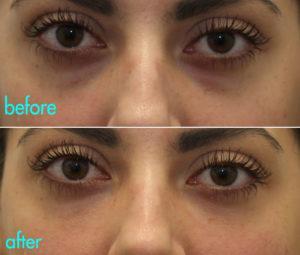Is it safe to have under eye or tear trough filler injections?
One of the most requested procedures in my practice is under-eye (or some people call this tear trough or infraorbital) fillers. Is it safe? Read on to hear my take…
The reason this procedure is so popular is because it’s a non-surgical, minimally invasive way to reduce or eliminate the look of eye bags and dark under-eye circles. There’s not a lot of downtime after the procedure (if any) and the results can last for a year or more.
But is it safe? In short, my informed opinion is yes, but with caveats. Read below to hear why.
My disclaimer: this blog post is not intended to give you specific medical advice, it is meant to share my extensive professional experience with under-eye fillers. Each person is different and may require a different approach. Under eye filler is considered “off-label” and currently no fillers are FDA-cleared for under-eyes but doctors can use products for off label indications including tear trough filling.
Under eye filler with Restylane using cannula technique
How can you have a safe under-eye filler injection?
No injector can give you absolute assurance that any procedure is 100% risk-free. But there are conditions that can reduce those risks to a level that the vast majority of people would consider to be acceptable. I’ve personally had the procedure myself after determining based on my knowledge and experience that it was safe.
There are techniques that I use to improve the safety of the procedure (e.g. cannulas, low-pressure injection, clean technique, anatomic understanding) but there are steps you can take as a patient to improve safety for yourself.
Read below to find out what conditions may lend a higher level of safety to the tear trough filler procedure:
What are the risks associated with facial and under-eye fillers?
All filler injections have the risks of bruising and swelling. Bruising after under-eye filler is less likely in my experience if a cannula is used.
Lumps and bumps, bluish discoloration (Tyndall) and visible filler material can occur but can be corrected with massage and/or enzyme injection (hyaluronidase or Hylenex) to dissolve the filler. The ability to reverse HA gel fillers improves their safety.
Allergy, inflammation, and infection are rare with HA gel fillers as hyaluronic acid is already in our skin. This is why HA fillers don’t require skin testing before injection. But there may be inflammation or infections if clean techniques are not used during the injection. It’s been theorized that low-grade, chronic infections can occur from biofilms (bacterial growth). Granulomas (inflammatory lumps) may occur due to allergy or immune reactions to the cross-linking process in some fillers. I suspect that the cross-linking used in Juvederm Voluma may cause inflammation in a small but significant percentage of people (this has been reported in the literature) and I never use Voluma under the eyes.
The most tragic and dreaded complication of under-eye fillers is injection into a blood vessel or compression of a blood vessel causing circulation compromise. If filler material were to affect the central retinal artery, visual loss could ensue. This is incredibly rare and in my opinion even more rare if a cannula is used.
In fact, a 2015 review article in Dermatologic Surgery Journal examined all the peer-reviewed literature on reports of visual complications from facial fillers and the most common injection sites related were between the brows or glabella (38%), nose (25%), nasolabial (13%) and forehead (12%). Under eye or tear trough injections were not in the top 4 related injection sites.
A video demonstration of my cannula under-eye filler technique
Should you get under eye filler?
Obviously the decision to undergo a cosmetic procedure is a personal one. If you have under-eye bags or dark circles and you are considering a non-surgical treatment, my recommendation is to have a consultation with a very experienced injector to get the best informed advice based on your specific situation.
You can read more about the cannula tear trough filler technique here. And a link to my podcast in which I talk to another skilled oculoplastic surgeon about this procedure is here.

